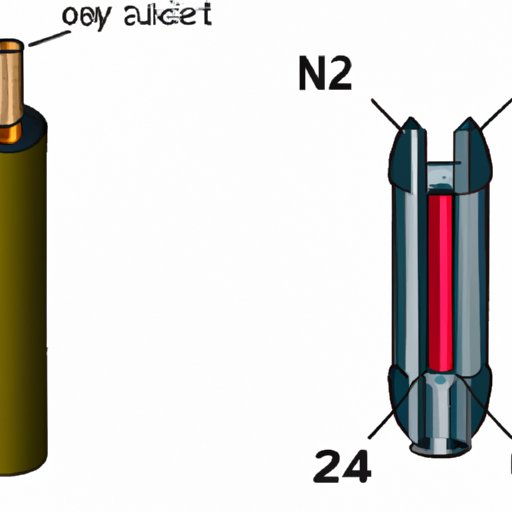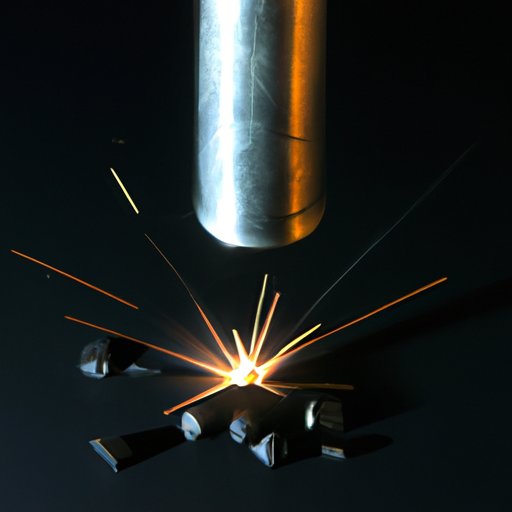Introduction
A bullet is a small metal projectile designed to be fired from a firearm. Bullets are used in hunting, self-defense, military operations, and target shooting. The purpose of a bullet is to cause damage or destruction when it impacts its target. For this reason, understanding how bullets work is essential for anyone who handles firearms.
Exploring the Physics Behind a Bullet
When a firearm is discharged, the force of the explosion propels the bullet forward through the barrel of the gun. This action is governed by Newton’s Laws of Motion, which state that an object in motion will remain in motion until acted upon by an external force. As the bullet moves through the barrel, it accumulates kinetic energy, which is the energy of motion. This kinetic energy is generated by the explosion of gunpowder, a type of propellant that burns rapidly, generating a large amount of pressure.

How Ammunition Works: The Anatomy of a Bullet
Bullets come in a variety of shapes and sizes, but they all have the same basic components. The most common type of bullet is the centerfire cartridge, which consists of a primer, shell casing, propellant, and projectile. The primer is a tiny cup filled with an explosive compound that ignites when struck by the firing pin of the gun. The shell casing is a metal tube that contains the propellant, which is usually gunpowder. The propellant is ignited by the primer, creating a burst of hot gas that propels the bullet out of the gun. The projectile is the actual bullet, which is typically made of lead or copper.
Inside Look at What Makes Bullets So Deadly
The velocity of a bullet is what makes it so dangerous. Bullets travel at speeds over 1,000 feet per second, giving them tremendous momentum. Momentum is the product of mass and velocity, and it determines how much force a bullet can impart on its target. Another factor that contributes to the lethality of a bullet is its spin. Most bullets are designed to spin as they move through the air, which helps them maintain their trajectory and improves their accuracy.
Rifling is the spiral grooves cut into the inside of the gun barrel. When a bullet is fired, it engages these grooves, causing it to spin rapidly. This spin stabilizes the bullet in flight, allowing it to travel farther and maintain its accuracy.

A Breakdown of the Mechanics of Bullets
The firing sequence of a bullet is fairly straightforward. When the trigger is pulled, the firing pin strikes the primer, causing it to ignite. The burning primer creates pressure, which forces the bullet out of the casing and down the barrel. As the bullet travels down the barrel, it is propelled by the expanding gases created by the burning propellant. The barrel also serves to guide the bullet and impart spin, which increases its accuracy.
Once the bullet leaves the barrel, it travels through the air at high speed. Upon impact, the bullet begins to expand, transferring its kinetic energy to the target and causing massive tissue damage. This process is known as expansion, and it is one of the main factors that contribute to the lethality of bullets.
Understanding the Components of a Bullet
The weight of a bullet is measured in grains. A grain is a unit of measurement equal to 1/7000th of a pound. Bullet weight is important because it affects the velocity of the bullet and its stopping power. Heavier bullets tend to travel slower and have more stopping power than lighter bullets.
The caliber of a bullet is the diameter of its projectile. Caliber is typically expressed in millimeters or inches and can range from .22 caliber to .50 caliber. Larger calibers tend to have more stopping power and greater range than smaller calibers.
Jacketed bullets are bullets with a thin layer of metal covering the outside of the projectile. This layer of metal helps reduce friction, allowing the bullet to travel faster and more accurately. Jacketed bullets are typically more expensive than non-jacketed bullets.

Breaking Down the Science of Bullets
Terminal ballistics is the study of how bullets interact with their targets. This field of study is concerned with the effects of bullets on living tissue and how different types of bullets behave differently upon impact. Terminal ballistics can help us understand the stopping power of different bullets and the amount of tissue damage they can cause.
Stopping power is the ability of a bullet to incapacitate its target. Stopping power is determined by many factors, including the velocity, momentum, and caliber of the bullet. Higher velocity bullets tend to have more stopping power than lower velocity bullets.
Range and accuracy are two other important factors that determine the effectiveness of a bullet. Longer ranges require more accurate bullets, while shorter ranges require less accurate bullets. The rifling of a gun barrel also affects the accuracy of a bullet; guns with deeper rifling tend to be more accurate than guns with shallow rifling.
Conclusion
In summary, bullets are highly sophisticated projectiles designed to cause maximum damage when they impact their target. Understanding the physics, mechanics, and science behind bullets is essential for anyone who uses firearms. By studying the components of a bullet, the laws of motion, and the effects of gunpowder, we can gain a better understanding of how bullets work and why they can be so deadly.
(Note: Is this article not meeting your expectations? Do you have knowledge or insights to share? Unlock new opportunities and expand your reach by joining our authors team. Click Registration to join us and share your expertise with our readers.)
